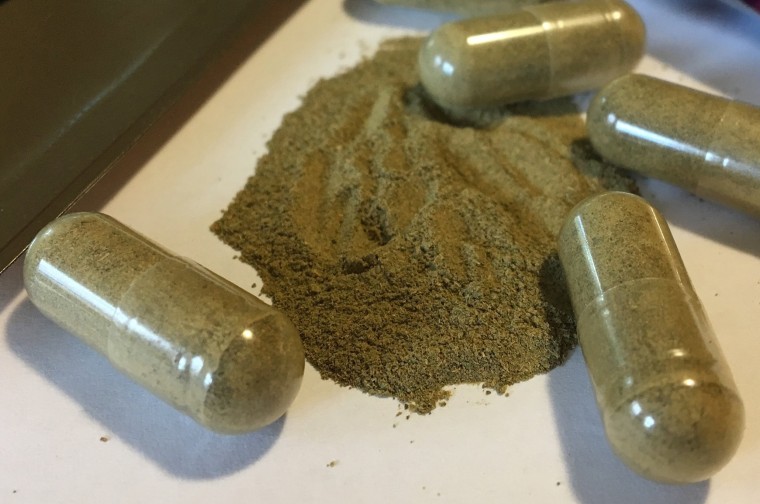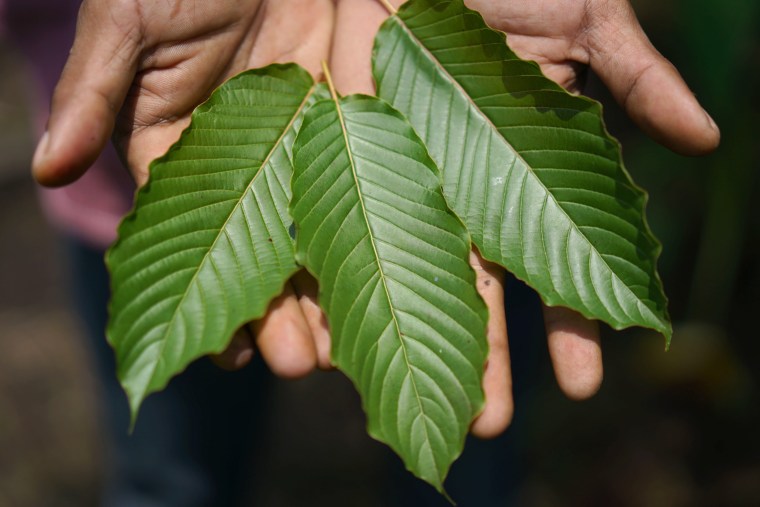The Summary
- Kratom, sometimes referred to as “gas station heroin,” is an herb with opioid- and stimulant-like effects.
- It can be fatal in very high doses but is not subject to much federal regulation.
- So states and cities have been banning kratom sales or enacting rules and restrictions.
Nearly two years ago, Beth Quinn’s son Brendan was found dead at 48 from an apparent overdose of kratom, an herb with opioid- and stimulant-like effects that have given it the nickname “gas station heroin.”
Quinn blames the lack of regulation over kratom for the death of her son, who left behind a 15-year-old daughter.
“There was no dosage advice,” said Quinn, a former newspaper editor who lives in upstate New York. “There was nothing except a ‘not our problem if you die, it’s on you, man.’”
Kratom is sold legally and widely at vape shops, gas stations and convenience stores in liquid, tablet or powder form. The American Kratom Association, which advocates for consumer access to the substance, says it’s a roughly $1.5 billion-per-year industry.
Kratom is not regulated as a controlled substance, though the Drug Enforcement Administration lists it as a “drug of concern.” The FDA has not approved kratom for any purpose, but supplements do not require the agency’s sign-off to be sold.
Kratom was the cause of 91 overdose deaths from July 2016 to December 2017, according to a report from the Centers for Disease Control and Prevention. But some estimates put the toll far higher: An analysis by The Washington Post found kratom listed as the leading or partial cause of death in at least 4,100 deaths from 2020 to 2022, and an investigation by the Tampa Bay Times last year found that more than 580 people in Florida alone had died from kratom-related overdoses since 2013.
In a letter published Monday in the journal Annals of Internal Medicine, a group of researchers called kratom an “emerging issue” and suggested that physicians consider asking patients about their kratom use, the same way they do about cannabis, cocaine, methamphetamines or heroin. The paper suggests that as of 2022, roughly 1.9 million people in the U.S. had used kratom, though the authors suggest that’s an underestimate.
The DEA sought to temporarily reclassify kratom as a schedule 1 substance in 2016, but reversed course following a backlash. So in lieu of federal oversight, a growing number of states and cities have been cracking down on kratom on their own.
A patchwork crackdown
At least six states — Alabama, Arkansas, Indiana, Rhode Island, Vermont and Wisconsin — had banned kratom entirely as of late last year, according to a report from the Congressional Research Service. Some cities have recently, as well: Tinley Park, Illinois, a suburb of Chicago, passed a ban in June. Newport Beach, California, did the same in May.
More common, however, are age-related restrictions. More than 15 states prohibit kratom sales to minors or to those under 21.

Kentucky was a recent addition to the list: A state law went into effect last month that bans the sale of kratom to anyone under 21, limits the ingredients that can go into kratom products and requires ingredients to be listed on labels. Georgia passed a similar law in May that will tighten regulations on kratom products and raise the minimum purchasing age to 21 when it goes into effect next year.
“Once I started doing research on the substance, I realized Georgians who were using kratom did not know exactly what they were putting in their bodies when they took it,” said state Rep. Rick Townsend, a Republican who sponsored the bill.
Townsend said he was inspired to push for the policy after two constituents told him that they had lost their son, in part, due to kratom.
Oklahoma also recently passed legislation instituting labeling requirements for kratom products. The state has banned kratom sales to minors since 2021.
Oklahoma Rep. Daniel Pae, the bill’s sponsor, said that he is open to “federal consistency” on kratom regulation, but that “given the political reality of Congress, I don’t anticipate them taking any action anytime soon.”
Oliver Grundmann, a clinical professor in the department of medicinal chemistry at the University of Florida, has been studying kratom since 2016. Although greater regulation is needed, he said, a federal ban might be ill-advised, given that the substance appears to help some people with opioid withdrawal.
“There are legitimate uses for it, but it needs to be in a controlled environment,” Grundmann said.
He added that the lack of federal regulation also means there is no reporting requirement for kratom overdose deaths, making its impact difficult to piece together.
“You basically have to look at medical examiner reports or death certificate reports in every state,” he said.
The American Kratom Association said it would welcome more regulation. Mac Haddow, a senior fellow on public policy with the association, called the current industry a “Wild Wild West.”
“A consumer should beware,” he said, adding that if the label information is not present or questionable, “don’t use it.”
Four groups of kratom users
Kratom contains a chemical compound called mitragynine, which can stimulate the same brain receptors as opioids. That is partially why it can become addictive, according to experts. At high concentrations, the substance can cause nausea, seizures, vomiting, difficulty breathing and, in the most extreme cases, death.

The FDA has issued advisories about the health risks of kratom and taken action against manufacturers who make misleading claims. But given the overall lack of regulation, the packaging on many kratom products does not include information about dosing, the concentration of active compounds or the other ingredients mixed in.
“No one wants to buy a product and have the product be laden with lead and arsenic and tin,” said Michael White, head of the Department of Pharmacy Practice at the University of Connecticut. “But I can tell you that there are a number of kratom products that are being sold right now that exceed the FDA regulations … for all of those heavy metals.”
White categorized kratom users into four primary groups.
The first is people with opioid use disorder who buy kratom either to tide them over until they can get more opiates or as an attempt to wean themselves off even harder stuff. The second is people who say kratom helps them with pain management. Then there are users with anxiety, depression or some other mood disorder, and finally a group that simply enjoys the stimulant effects.
Emmy Hartman, a TikTok influencer who has posted about kratom, fits into that last group. She said she started using it to concentrate.
“I drank it to do my taxes and I was having a great time,” Hartman said in an interview in June. “I felt relaxed, I felt a little happy. So I kept drinking them.”
Hartman admitted that she did not know much about what was in kratom when she first tried it.
“I called my one friend and showed him and he was like, ‘Emmy, did you read what’s in that?’ And I was like, ‘No.’ The way he described it was ‘gas-station crack.’”
Quinn doesn’t know why her son Brendan used kratom. He had struggled with drug and alcohol abuse, she said, and also had chronic shoulder pain from a surgery. The toxicology report following his death, which NBC News reviewed, showed that he had nothing in his system except caffeine, nicotine, kratom and an anti-seizure medication that he’d been prescribed.
“We went into the house and found a box of kratom empty,” Quinn said. “Just because it’s sold at the convenience store doesn’t mean it’s not dangerous.”






